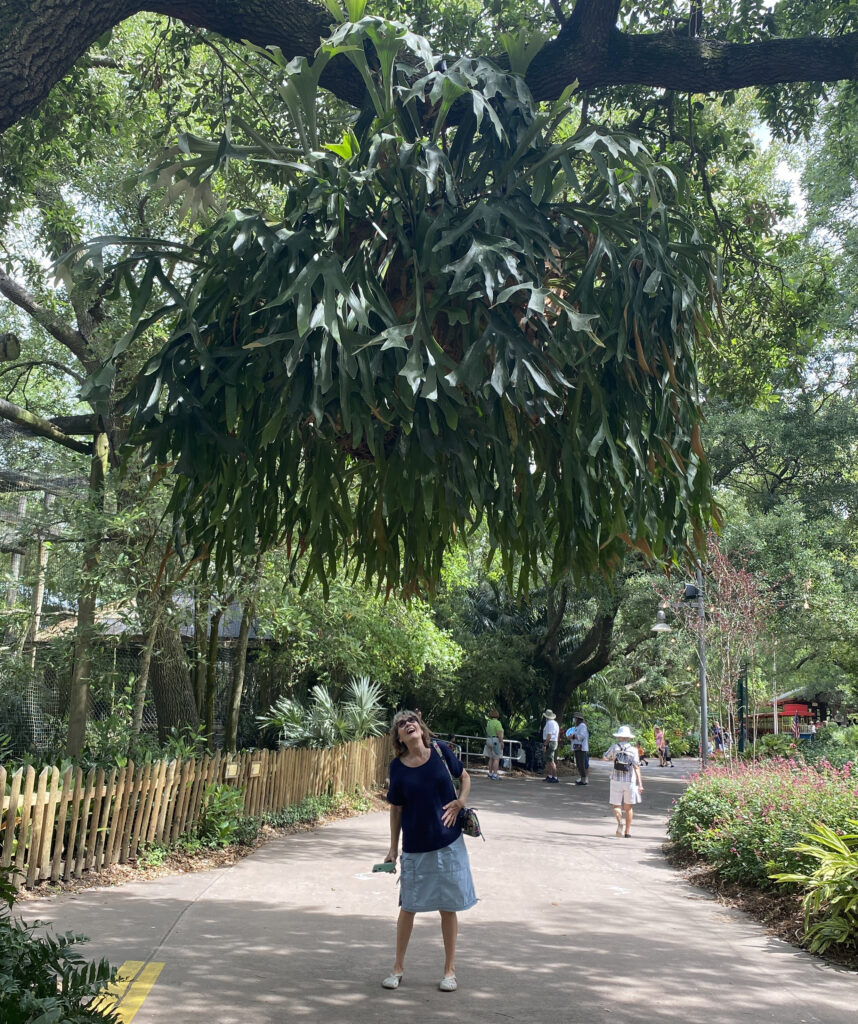By Pat Foster-Turley, Ph.D.
June 17, 2021

When you visit a zoo you expect to see animals, of course, but mostly in their enclosures. And you expect to see some vegetation in and among the exhibits too. On a recent visit to the Jacksonville Zoo with my friend Susan Gallion, however, we saw so much more than this.
For one thing the zoo is heavily landscaped with shrubs, trees and flowers that originate in the various continents represented by their animal collection. The African area was fronted by the Savannah Blooms garden showcasing many different types of tall grasses and shrubs native to that continent. The Asian area included a bamboo garden with tall canes that rattled in the wind giving an aural background to our animal viewing. We were flabbergasted at some of the plants, and spent a while admiring and photographing the largest staghorn fern either of us had ever seen. The pond lilies were beautiful and were blooming in colors I had never seen in pond lilies. Everywhere we looked there was some group of plants to marvel at.
Just beyond the touchable stingray exhibit we encountered a deafening cacophony and looked up to see where the noise was coming from. Above our heads was a vibrant, squawking rookery of black-crowned night herons, with adult wild birds tending their babies in the nests. Another wild bird rookery, of wood storks, was active and noisy in trees bordering the walkway to the elephant area. Some of these birds were so close they could almost be touched. But it did not bode well to stand under these trees very long. The many white blotches on the walkway beneath them told a cautionary tale.
We walked through the North American area of the zoo, and found a few young children transfixed by something in the bald eagle display and it wasn’t an eagle. Ever curious we edged into the group and saw a remarkable sight, at least for those kids. A garter snake was consuming a toad, right by the fence! It was a fine time to tell them about the value of snakes, and how lucky they were to see one in action. We even discussed if we could eat the snake or toad. “No way!” they squealed.
Elsewhere Susan and I entered one of the animal exhibits where visitors were encouraged to purchase nectar to feed the lorikeet birds inside the aviary. Even without a purchased cup of nectar the brightly colored lorikeets were all around us. One even landed on Susan’s shoulder unbidden and she snapped a shot before it flew away again.

It was a slow day for the volunteers and zookeepers manning the aviary, and Susan and I quickly became friends with them when I explained my own experience as a zoo education director for many years at Marine World-Africa USA in California. So, when it came time to feed the carnivorous kookaburra some dead mice, we were allowed to watch the process. The kookaburra did not seem to be hungry and did not lunge at the mice tossed its way. It turns out that not long before the keepers had seen the bird eating a snake it found in its aviary. Looks like snakes are all around the zoo. Great!
There were a number of other interactive experiences offered to zoo visitors too. People were allowed to touch the stingrays in a pool, as long as people washed up at a nearby sink before doing so, to avoid contaminating the water. Elsewhere giraffes stretched their necks outside their enclosure where people held vegetation to feed them.
And there’s a lot more to the Jacksonville Zoo then the sights, smells and tactile activities available on zoo grounds. The zoo is involved in a number of global conservation efforts, including projects in Africa for gorillas, bonobos and okapis; Rupununi habitat conservation in Guyana; programs to conserve Central American river turtles and Puerto Rican crested toads and other efforts too. And, if and when injured or distressed manatees are rescued in north Florida, they are treated and rehabilitated and eventually released again into the wild at the zoo’s $2.1 million Manatee Critical Care Center.
Remember that old Simon and Garfunkel song, “It’s all happening at the zoo?” Well, I’m happy to report that it’s all happening at our nearby Jacksonville Zoo. Check it out!
Pat Foster-Turley, Ph.D. is a zoologist on Amelia Island. She welcomes your nature questions and observations at [email protected].

I love our zoo! You’ve inspired me to make another visit soon, (although I don’t really need to see the snakes). Still a little traumatized after a recent visit to Tuesday Morning where there was one crawling around the outdoors decorations section. This was followed up by three cashiers trying to herd it out the door (it didn’t want to go). Some screaming, some crashing (fragile birdbath bit the dust) before one very brave cashier got it out the door.